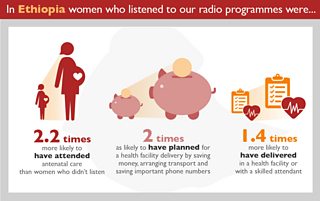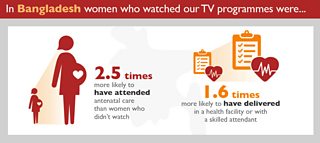Health communication changes lives by reaching millions
Sophia Wilkinson
Acting Head of Health and Resilience, Βι¶ΉΤΌΕΔ Media Action
Tagged with:
To mark the launch of our site, Sophia Wilkinson explains how health communication can make a big difference at scale – for less than the cost of a can of coke per person.
“But what about the impact?”
This is the question I'm asked the most after I’ve told an audience that, quite literally, millions of people listen to our radio shows and watch our TV programmes about . The other question I routinely get is:
“I don’t care how big your audience is! What I want to know is whether anything has changed?”
What people often don’t realise is that the more people you reach, the bigger the difference you can make. You don’t have to choose between the two.
Skilfully designed and well-executed media and communication projects can not only change behaviour and norms, they can do so at scale. Offering both quality and quantity, such interventions should be immensely attractive to those working to solve the world’s costliest and most widespread health challenges.
I’m going to brag. In Ethiopia alone, some listened to our radio shows about different aspects of pregnancy, birth and newborn health over the course of just one year – and 14 million did so regularly. This means in the three states where we surveyed – Amhara, Oromia and SNNPR (Southern Nations, Nationalities, and Peoples' Region) – almost half of all adults listened to our shows.
But aside from professional pride, why does this box office success matter when you’re not looking to drive up profits from ticket sales?
It matters because of the scale of the challenges we’re trying to solve.
In Ethiopia, , 29 will die before they’re even a month old and 48 won’t make it to their first birthday. And every year, due to pregnancy-related complications.
Of course, we all know that the death of many of these mothers and newborns could be avoided. But it’s not just about providing good quality, accessible health services. It also requires lots of people to do things differently in their day-to-day lives. Millions. Not just hundreds.
The Ethiopian women who listened to our shows did just that. They were more likely to have: one, received antenatal care, two, made arrangements for having their baby in a health facility and, three, given birth in a facility or with a skilled attendant looking after them.

And this wasn’t due to wealth, or education, or proximity to services - our research controlled for these factors - and while it doesn’t provide causal data, this analysis helps us to be more confident in these results.
There are other reasons why reaching lots of people matters. As the highlighted back in 2015, human beings are very social animals. We don’t like being alone. We live and work in communities, big and small. We have friends. We spend time with our families.
Of course, one consequence of spending time together is that how we behave is deeply influenced by what those around us are doing, or what we think they’re doing and expect us to do. It follows that if more and more people start doing something, we can expect a snowball effect. Reaching more people will create .
Finally, reach matters when it comes to delivering value for money. Another accusation frequently bandied about is that media projects are expensive, especially if high-quality television dramas are part of the mix. Well, yes, if only a few hundred people watch that drama then it wouldn’t be very cost-effective to produce.
But it cost us just 23 pence per person to reach 93 million people in Bangladesh, Ethiopia, India and South Sudan with potentially life-saving information, using all manner of communication tools, from TV dramas to community discussions. Critics might dismiss our programmes as ‘all talk and no action’, but people are taking their newfound knowledge and doing things differently because of it.
Just take a look at what our research in Bangladesh is telling us:

Those who listen and watch our programmes have access to health information to help them make healthier choices…and for less than the cost of a can of coke. Sounds like a pretty good investment to me.
If you want to find out more about how Βι¶ΉΤΌΕΔ Media Action used media and communication at scale to improve maternal, newborn and child health, go to our digital platform, .
Sophia Wilkinson is Βι¶ΉΤΌΕΔ Media Action’s Acting Head of Health and Resilience; she was previously the organisation’s Senior Health Adviser. Sophia’s most recent publication is , which reflects on Βι¶ΉΤΌΕΔ Media Action’s maternal and child health partnerships with governmental and NGOs in Bangladesh, India and Ethiopia.
